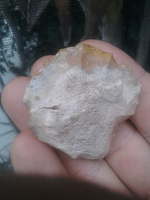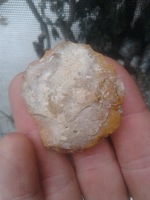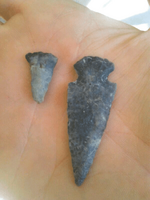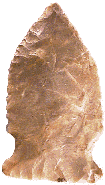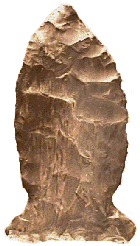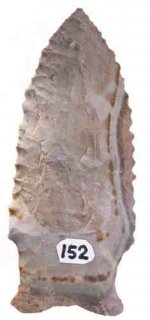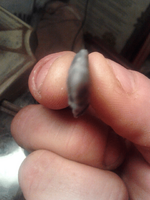Navigation
Install the app
How to install the app on iOS
Follow along with the video below to see how to install our site as a web app on your home screen.
Note: This feature may not be available in some browsers.
More options
You are using an out of date browser. It may not display this or other websites correctly.
You should upgrade or use an alternative browser.
You should upgrade or use an alternative browser.
what would you call this?
- Thread starter GatorBoy
- Start date
old digger
Gold Member
- Jan 15, 2012
- 7,512
- 7,351
- Detector(s) used
- White's MXT
- Primary Interest:
- All Treasure Hunting
I would think it is a small biface chopper. Nice Find!
old digger
Gold Member
- Jan 15, 2012
- 7,512
- 7,351
- Detector(s) used
- White's MXT
- Primary Interest:
- All Treasure Hunting
This is just a guess, but my thinking is that after the meat was dried, it would have been chopped up with a small chopper like the one shown. Then, the chopped up meat was ground down finer with the mano/metate, and mixed together with dried local fruits to make pemican.
JustPlainStrange
Jr. Member
- Feb 26, 2013
- 38
- 14
- Primary Interest:
- All Treasure Hunting
Proper name = biface. Nothing more.
JustPlainStrange
Jr. Member
- Feb 26, 2013
- 38
- 14
- Primary Interest:
- All Treasure Hunting
Because it's not a specific tool or "style". It could have been a piece in the midst of thinning, things weren't going right so they discarded it. It could have been a rudimentary expedient tool needed for a quickie task. It's not a readily recognized form - it's a biface.
Ty for the welcome.
Ty for the welcome.
JustPlainStrange
Jr. Member
- Feb 26, 2013
- 38
- 14
- Primary Interest:
- All Treasure Hunting
You obviously do not know Florida patina
I'm very familiar with Florida relics. By the way, your other point isn't a Greenbrier. Bolen maybe, not Greenbrier.
tomclark
Bronze Member
- Dec 18, 2006
- 1,177
- 1,641
- Detector(s) used
- ShadowX2, TEJON, Eyes, Pony Shovel
- Primary Interest:
- Other
Ah Duval. They don't all have that bulbous base that fools people over type, but almost all have the diamond cross section, a diagnostic trait boom! LOL


Your piece I would call a small scraper, like a thumbnail only bifacial, looks ground on top no doubt used in hand, even the "base" could have been used and looks ground/worn. Sweet tool. Yes, patina looks old to me, too. Nice color don't think it was heat treated> I've seen similar colored chert in Hillsborough Co.
I've seen similar colored chert in Hillsborough Co.
FL Greenbriar, rice-grain chert, filthy ground base and notches, reported to the IFP I have a paper says I own it.



Your piece I would call a small scraper, like a thumbnail only bifacial, looks ground on top no doubt used in hand, even the "base" could have been used and looks ground/worn. Sweet tool. Yes, patina looks old to me, too. Nice color don't think it was heat treated>
 I've seen similar colored chert in Hillsborough Co.
I've seen similar colored chert in Hillsborough Co. FL Greenbriar, rice-grain chert, filthy ground base and notches, reported to the IFP I have a paper says I own it.

Last edited:
- Jan 27, 2009
- 18,788
- 11,896
- 🥇 Banner finds
- 1
- Detector(s) used
- Tesoro Conquistador freq shift
Fisher F75
Garrett AT-Pro
Garet carrot
Neodymium magnets
5' Probe
- Primary Interest:
- All Treasure Hunting
I think the secondary work on the edge is the clue to the tool. As far as dating it unless it is found in context they were made by every culture. Because another type is beside it on the ground means nothing. But if it was dug out of the ground it means everything. I am not a scientist and can not date by patina alone. And being oval does not make it paleo or archaic. The title here was what would you call it? Biface tool with secondary edge work. Nice tool at that
- Jan 27, 2009
- 18,788
- 11,896
- 🥇 Banner finds
- 1
- Detector(s) used
- Tesoro Conquistador freq shift
Fisher F75
Garrett AT-Pro
Garet carrot
Neodymium magnets
5' Probe
- Primary Interest:
- All Treasure Hunting
Proper name = biface. Nothing more.
Welcome to artifacts. Look forward to your post and knowledge. All opinions are welcome.
tomclark
Bronze Member
- Dec 18, 2006
- 1,177
- 1,641
- Detector(s) used
- ShadowX2, TEJON, Eyes, Pony Shovel
- Primary Interest:
- Other
GB, that IS a schweeeeet example of Bulbous Base Duval. Classic all the way
 So many of that type are funky. I have only one, maybe two out of a bunch that are as well done and classic boom.
So many of that type are funky. I have only one, maybe two out of a bunch that are as well done and classic boom.
 So many of that type are funky. I have only one, maybe two out of a bunch that are as well done and classic boom.
So many of that type are funky. I have only one, maybe two out of a bunch that are as well done and classic boom.Top Member Reactions
-
 3444
3444 -
 1972
1972 -
 1907
1907 -
 1135
1135 -
 1084
1084 -
 1002
1002 -
 875
875 -
 866
866 -
 859
859 -
 774
774 -
 758
758 -
 676
676 -
 653
653 -
 567
567 -
 504
504 -
 452
452 -
 446
446 -
 412
412 -
 403
403 -
E
397
Users who are viewing this thread
Total: 2 (members: 0, guests: 2)


